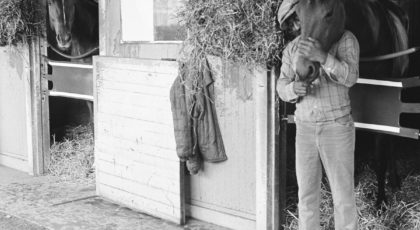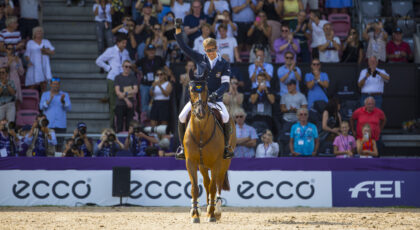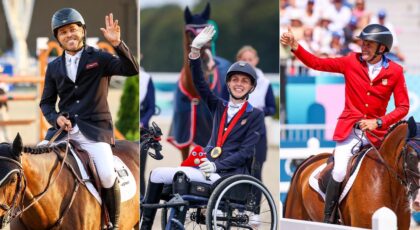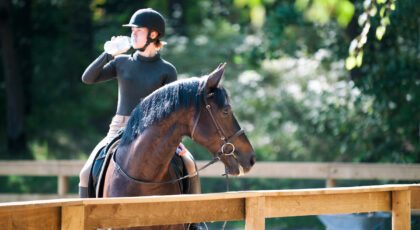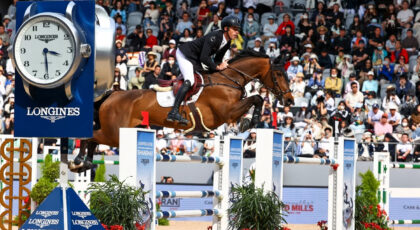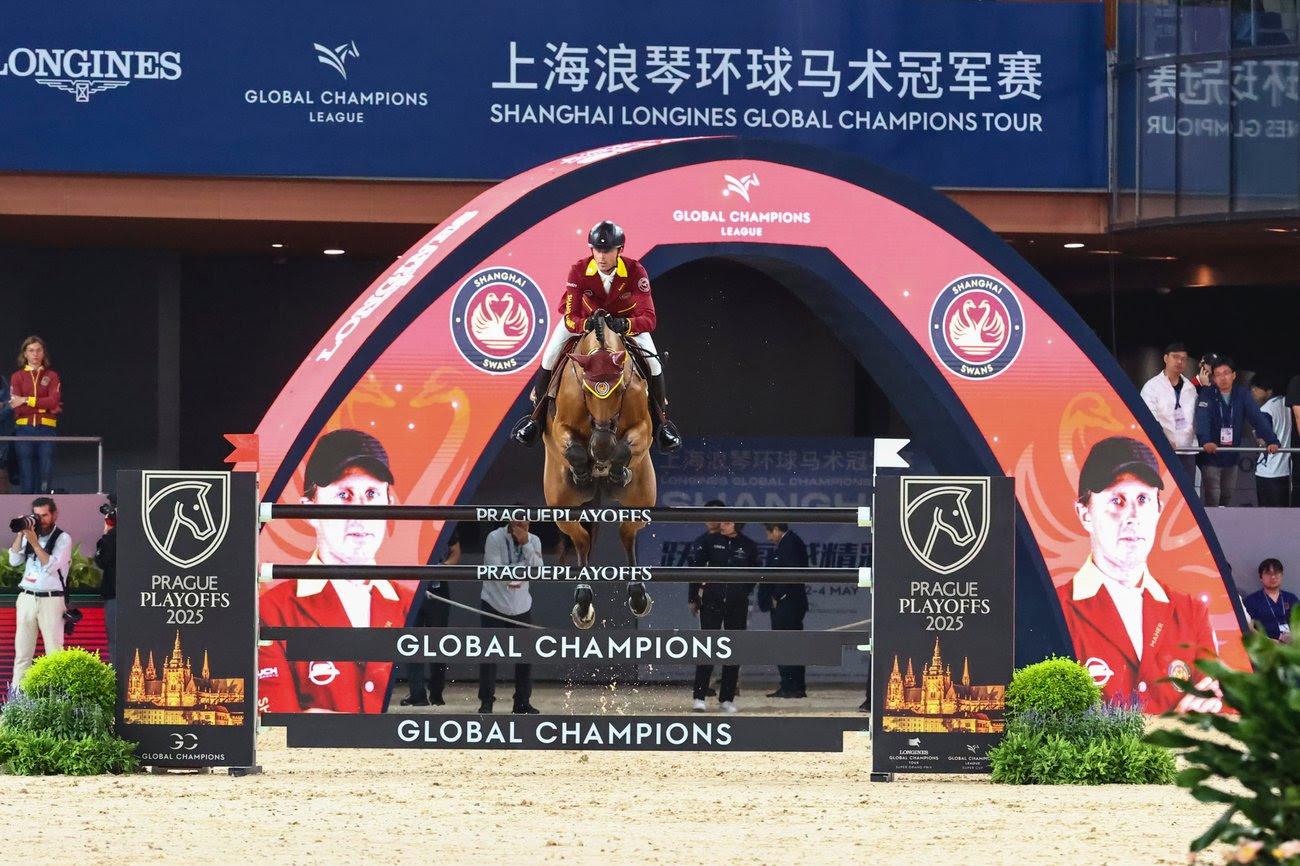Hundreds of miles of untouched, virgin land, speckled with a myriad of horses, goats, sheep, cattle, yak and little running ground squirrels lie before me. Falcons fly overhead, as scavenging vultures stay on alert for any possible prey.
Mountains surround my ger camp. Some enveloped by the greenest of velvet-like moss grasses. Others, barren of any wildlife, only punctuated by imposing and impressive boulders reminiscent of the Stone Age. Behind the camp, a surprisingly lush pine forest tops the tip of another mountain—like a star atop a Christmas tree. A river runs below, winding its way between the ranges. The Orkhon River, made famous by the Orkhon falls located in the heart of central Mongolia.

This is Mongolia. And for miles on end, the only signs of life are the two gers across the river—mushroom-like white tents—home to local nomad families. Across this very river, a swiftly moving cloud of dust is visible, and is none other than the local herdsman reining in his horses. Right, left, forwards, backwards, the cloud of dust shifts at an alarmingly fast pace. His agility on horseback is impressive.

The Land of the Horse
“A Mongol without a horse is like a bird without the wings.” Elizabeth Kendall, 1911

They say that horses are the spirit of Mongolian culture. According to J. Tserendeleg, president of the Mongolian Association for the Conservation of Nature and the Environment, “It is not possible to imagine Mongolian history without horses…Mongolia is not Mongolia without horses.”

Looking over this magnificent valley and its limitless herds of grazing mares and foals, the place of the horse in Mongolian society is of no surprise. Nor is it a surprise to see a seven year old bareback, galloping full speed through the tall grasses along the river bank. This really is Mongolia. This really is the land of the horse. And I really am fulfilling a dream in one of the most remote parts of the world.

As it turns out, I have been passionate about horses and riding since I was a little girl. From learning the basic skills of horsemanship at Claremont Riding Academy in the early nineties in New York’s Upper West Side, to training in the hunter-jumper ring outside Toronto, to finally taking on the so-called “sport of kings”—polo—outside Buenos Aires and now in France—it’s become a drug I just can’t live without.
Coming to Mongolia, was therefore no coincidence. It was intrinsically linked to my passion for this adored four hoofed animal, and this most addictive sport, revered to as polo.
Yes, I traveled 29 hours to the heart of central Mongolia to play polo. Crazy? Perhaps to some. Peculiar? Surely for others. Uncommon? No question about it. Would I do it again? Most definitely.
What many may not know, is that Mongolia is the homeland of polo. Many claim that the sport originated in this very country in as early as the 4th Century BC, used as a training method for cavalry units. Legend also claims the game was practiced in the Middle Ages by Genghis Khan’s armies who were reported to have substituted the heads of their victims for balls. In the late 1200s, however, at the fall of the Mongol Empire, the sport of kings is said to have disappeared completely from the region, not to return until the end of the 20th century.
So, as crazy and peculiar as it may seem to certain, polo in Mongolia made an incredible amount of sense to me. This is a trip I had wanted to take for quite a while, and so this past July, when I was invited to participate in a polo tournament organized and hosted by the Genghis Khan Polo Club during the annual Mongolian Naadam festival, I knew I had to book tickets to Ulan Bator ASAP.

The Genghis Khan Polo Club
The trip was long. But, it was worth it. Paris—Moscow—Ulan Bator—Karakorum—Orkhon Valley. From start to finish 29 hours, including 8 of the most grueling and uncomfortable hours my body has ever endured, driving in a local bus—paved roads in Mongolia being virtually inexistent, and a solid back (and stomach) a most vital commodity.
An “unforgettable” drive, one could say, is thus how began this story. And, the Genghis Polo Club, is truly in fact, an incredible story in itself.
A story that began in the 1990s when German filmmaker, Christopher Giercke, who was shooting on location in Mongolia, discovered and fell in love with Central Mongolia’s Orkhon Valley, but not only. He also fell in love with a beautiful Mongolian, by the name of Enkhe.

Looking to impress the object of his affection he proposed to show her, what he believed, was the most magnificent region of the country: a small plateau nestled in the verdant Orkhon valley, overlooking the famous river Orkhon whose tributaries flow out to Siberia and Lake Baikal in Russia. Instagrammable it was—well, would have been for you and me—but Enkhe’s reaction was not that which Christopher expected. Unbeknownst to Christopher, he had actually brought Enkhe (who also happens to be a direct descendant on her mother’s side of Genghis Khan’s brother, Khasar) back to her nomadic homeland. Her father was, in fact, born just across the river in one of the surrounding valleys.

A Fortunate Coincidence
A fortunate coincidence, yes. The beginning of a most unique adventure, absolutely.
What ensues is a love story between the couple, the Orkhon valley and the majestic sport of kings, polo. For it is Christopher who a few years later set up camp on this very plateau. And, it was he who, inspired by local children galloping full speed bareback across the valley, decided to establish a local polo club, a local polo team and reintroduce the sport of kings back to its very homeland.
The equation for Christopher was, and remains, simple. Mongolians are exceptional riders. Most begin to ride before they can walk, carried in their parents dels—side-buttoned robes belted with wide silk belts—on horseback. As was observed by a Franciscan monk by the name of Giovanni de Carpini in the 1240s, Mongolian “children begin as soon as they are two or three years old to ride and manage horses and to gallop on them…they are extremely agile and also intrepid. Young girls and women ride and gallop on horseback with agility like men.” Putting two and two together it was obvious: should the proper training be provided, Mongolian children could also become excellent polo players.

Every year, over thirty thousand children, between the ages of 6 and 12 participate in the Naadam, the annual traditional festival held during Mongolia’s National Holiday from July 11-13, featuring horse races over distances of 10 to 40km. Their prowess on horseback is unimaginable. Their skill and horsemanship, remarkable. Once a child becomes a teenager, however, he becomes too heavy for the horses and can no longer participate in the races, rendering him, in essence, the ideal contender for polo training.
An incredible riding potential exists within Mongolian society. Christopher instantly noticed it, decided to seize it and made it his mission to bring polo back to Mongolia and increase its awareness across the country, but also around the globe.
The Polo Club
Bring back polo to Mongolia he did—with the very first polo ball hit at Genghis Khan Polo Club in 1998.
Today, the club continues to operate as a summer polo training camp.
The picturesque tented camp is set up each summer for training, but also to host a myriad of personal guests and international polo players invited by Christopher, Enkhe and their three children. Located within the Orkhon Valley, a UNESCO World Heritage Site Cultural Landscape, the camp is situated an hour’s drive outside Karakorum—the capital of the Mongol Empire in the 13th century—and is set up at an altitude of roughly 1500m, far enough removed from any mobile phone network to be perfectly disconnected from reality.

The camp is as traditionally Mongol, as you can get. Gers, yes. Electricity, no. 3G and Wi-Fi, in your dreams.
And yet, its comfort equals that of a 5 star hotel, just “à la” Mongolian.
Impeccable traditionally decorated gers, beyond comfortable double beds (a nice change from traditionally minuscule single Mongol beds), luxuriously soft (and warm) cashmere blankets (it gets a little cold at night), a bath house with wooden tubs and hot water, a Shiatsu masseuse for post-polo massages, an incredible chef to taste local (and more familiar) delicacies, and a Pinterest-worthy, candle lit dinning ger, in which a simple dinner is transformed into a most lavishly magical experience.
DON’T MISS | Mongol Derby: The World’s Longest, Toughest Horse Race

Mongol Polo
But enough about the camp. Back to polo. Back to horses. For, to play polo in Mongolia, is to veritably step, or gallop, back in time, to a more rugged and authentic sporting-spirit. To the roots of modern horsemanship.
The horses are not the streamlined Argentine Criollos. The mallets are not 53s or 52s. The field is not the golf-green terrain of Pilar or Hurlingham. The sounds are not the familiar English or Spanish spoken across a more “typical” polo field. And yet, the energy, adrenaline and team-spirit are more dangerously contagious than anywhere else, reminding you just why you travelled quite so far to get some more stick and ball under your belt.
A chance to “Ride in some of the most unspoilt, rugged and breathtaking landscapes on earth,” according to Christopher Giercke—yes that’s exactly why I came all this way.
The Genghis Khan polo team is over 15 players strong. “Strong” being the key word. For, although they may not have the allure of the Argentine, or the panache of the Brits, by god are they ever skilled polo players.

The team counts men, women and youths alike. Has a stable of 60+ polo horses. And, travels extensively internationally, participating in tournaments in England, South America, Australia, Singapore, Thailand…
So this is what I was up against.
Stepping onto the field for our first “Mongol chukker”, and taking in the breathtaking vistas that surrounded me, was perhaps one of the most overwhelming moments of the experience. The scene was quite literally out of a Hollywood production: a polo field, nestled at the heart of the Mongolian steppe. A truly “out of this world” experience. How was I ever going to be able to keep my eyes on the ball in these surroundings?
But before I get into the matches themselves, a few words deserve to be written about the Mongol horse. For standing between 12 and 14 hands, a Mongol horse, or pony, is quite a bit shorter than an Argentine Criollo, and completely unlike any other horse I have ever ridden.
Short, stocky, a little awkward, most definitely. But, what it lacks in height, the Mongol horse makes up in its energy and drive. Born and raised in the heart of the Mongolian grasslands, a Mongol horse has and will never know the confines of a stable, stall, or a fenced-in pasture, and as such is truly semi-wild in state and nature.

Spunky little bullets, they are a riot to ride (and play on). And play you can, for hours on end, however, with much shorter mallets than your habitual 52—try a 46.
So there we were, my friend Wilfried and I, 2 clearly unconventional Parisians, atop our mounts, carrying our 46s, and ready to play against a team of Mongol polo players in the heart of Mongolia. The sights, the sounds, the terrain, the mounts, it was all new to us. We were truly venturing into new polo territory.

We lined up for the first chukker. The horses couldn’t stand still, their ears flickering, the hooves teetering, their nerves tensing up. It was about to start. And, just then, the ball was thrown in. One of our teammates hit it out, and…off, off they went.
Any nerves we may have had waiting for that throw in, disappeared in the fraction of a second as we galloped full speed ahead, in line, keeping our eyes on the ball, on our teammates and on any potential riding off or hooking from the adverse players. The match was swift in speed, high in adrenaline, and the Mongols proved to be incredibly skilled and tactical polo players.
The 7 minutes flew by and were followed by a number of other chukkers during our sojourn at Genghis Khan. And, what we lacked in knowledge of the Mongol language (somewhat essential during a local match), we made up for in our drive to step up our polo game and truly embrace this Mongol polo.
An Unforgettable Experience
The chukkers, the ponies, the adrenaline and the crazy Mongol match yelling—neither Wilfried, nor I understood—were some of the best moments at the camp, but not the only great ones.
The evening drinks on the grassland “terrace” overlooking the Orkhon river—where I am sitting writing this piece—drinking Gobi beer, and reliving the day’s events, matches and not so uncommon Mongolian “surprises” with the other guests present—were truly unforgettable.

As were the Sunday evening parties, during which family, guests, polo team and staff all head down to the tack ger for a most unique vodka and European pop music-filled night, lasting until the early hours of the morning (and worth the next morning’s headache).
Yes, everything about the Genghis Khan Polo Club, about Mongolia, about its horses, and its famed sport of kings, will stay ingrained in my memory forever.
As Elizabeth Kendall once said, “To appreciate the Mongol you must see him on horseback—and indeed, you rarely see him otherwise, for he does not put foot to ground if he can help it.”
How right she was.






Article originally published at www.windielust.com


 September 15, 2015
September 15, 2015 














